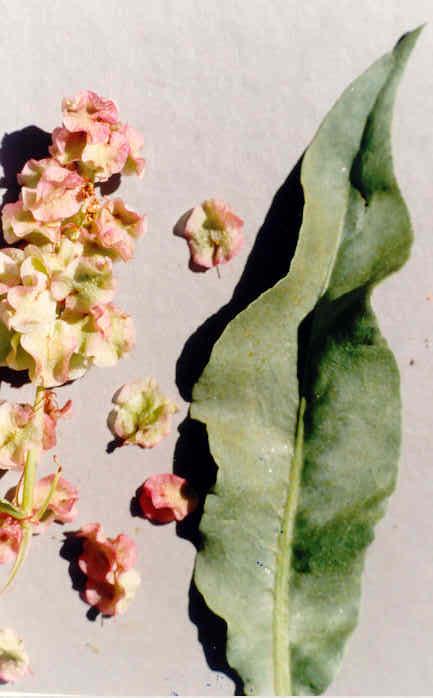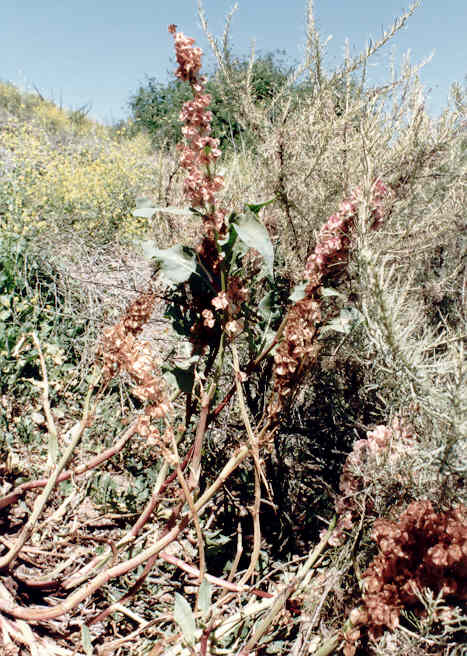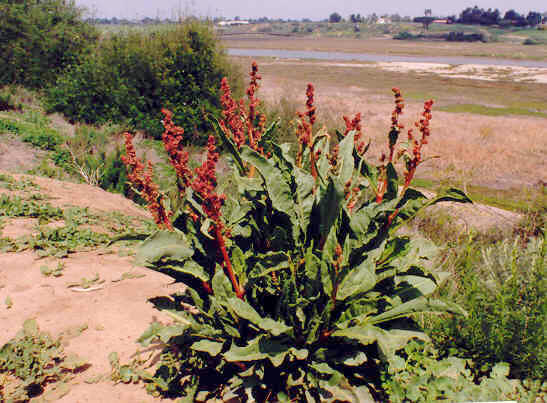
Rumex hymenosepalus Torrey
 |
Rumex hymenosepalus Torrey
Polygonaceae (Buckwheat Family)NativeWild RhubarbCanaigreWild Pie-PlantDesert Rhubarb |
May Photo
Plant Characteristics:
Perennial with a cluster of tuberous roots; stems smooth, somewhat
reddish, 6-12 dm. high, stout, without axillary shoots or tufts; lvs. very
fleshy, oblong or oblong-elliptic, 0.6-3 dm. long, on shorter petioles, acute,
crisped or margins, the sheaths 1-3 cm. long; panicle compact, 1-3 dm. long,
pinkish; pedicels 8-12 mm. long, jointed near middle; outer sepals ca. 2 mm.
long, the valves in fr. 8-14 mm. long, cordate-ovate, reticulate; nutlets 4-6
mm. long.
Habitat:
Common is dry sandy places, mostly below 5000 ft.; Coastal Sage Scrub, V.
Grassland, Chaparral, Joshua Tree Wd., Creosote Bush Scrub; L. Calif. to Kern
and San Luis Obispo cos.; Wyo., Tex. Jan-May.
Name:
Rumex, the ancient Latin name.
(Munz, Flora So. Calif. 705).
Hymenosepalus, sepals membranous.
(Bailey 16).
General:
Uncommon in the study area having been found only on a sandy bank at the
northerly end of Eastbluff. Additional
plants have been found in subsequent years in the same general location.
John Johnson has commented that this plant was more plentiful at one
time. (my comments). The tuberous roots contain up
to 35 percent tannin and have been used for tanning leather.
In early spring, stems and leaf stalks are cooked like Rhubarb, which
they quite resemble. Leaves are
sometimes eaten, but are cooked in several changes of water to remove the bitter
tannin. The Hopi Indians of Arizona
treated colds with a tea of Wild Rhubarb root.
The Navajos used the powdered root for treatment of sore throat, while
others boiled it for the same purpose. A
tea made from the root was sometimes used on skin sores. The Navajos also used the seeds in mush.
(Clarke 107). Closely related to the garden
rhubarb, Rheum rhaponticum, and also to dock and sorell.
In early days in both Utah and southern California housewives used its
stems as a substitute for cultivated pie-plant, finding them quite acceptable.
The Indians have long used the root in the tanning of buckskins, and they
also found in it a bright mahogany-brown dye with which to paint their bodies.
Of late this plant has been attracting much attention under the name
"canaigre" and it is hoped that it will prove a valuable substitute
for tan bark. If it does, we shall
hail it with delight as the savior of our beautiful oak forests.
Tannin exists in large quantities in the thick roots; but it is yet a
question whether it will prove remunerative to the farmer as a crop.
At Rialto a company has been formed, which employs many men to gather and
prepare the roots, and there will soon be thousands of acres of it under
cultivation. (Parsons 384). Parson's book was published in 1909. (my comment).
The Cahuilla Indians, inhabitants of the Colorado Desert, the San Jacinto
and San Bernardino Mountains ate the crisp juicy stalks as greens. The roots,
which contain up to 35% tannic acid, were used in tanning hides.
(Bean and Saubel 134). The
Kawaiisu Indians of the southern Sierra Nevada Region gathered the seeds of
Rumex hymenosepalus using a seed beater to knock them into a gathering
basket. The seeds were
parched, ground in a mortar and boiled into a thick gravy. (Campbell 165).
About 140 spp., widely distributed.
(Munz, Flora So. Calif. 705).
Text Ref:
Munz, Flora So. Calif. 707; Roberts 34.
Photo Ref:
Mar-May 90 # 17,18,19; Feb-April 91 # 13.
Identity: by R. De Ruff, confirmed by John Johnson.
First Found: March 1990.
Computer Ref: Plant Data 392
Have plant specimen.
Last edit 10/15/04.
 |
 |
May Photo March Photo